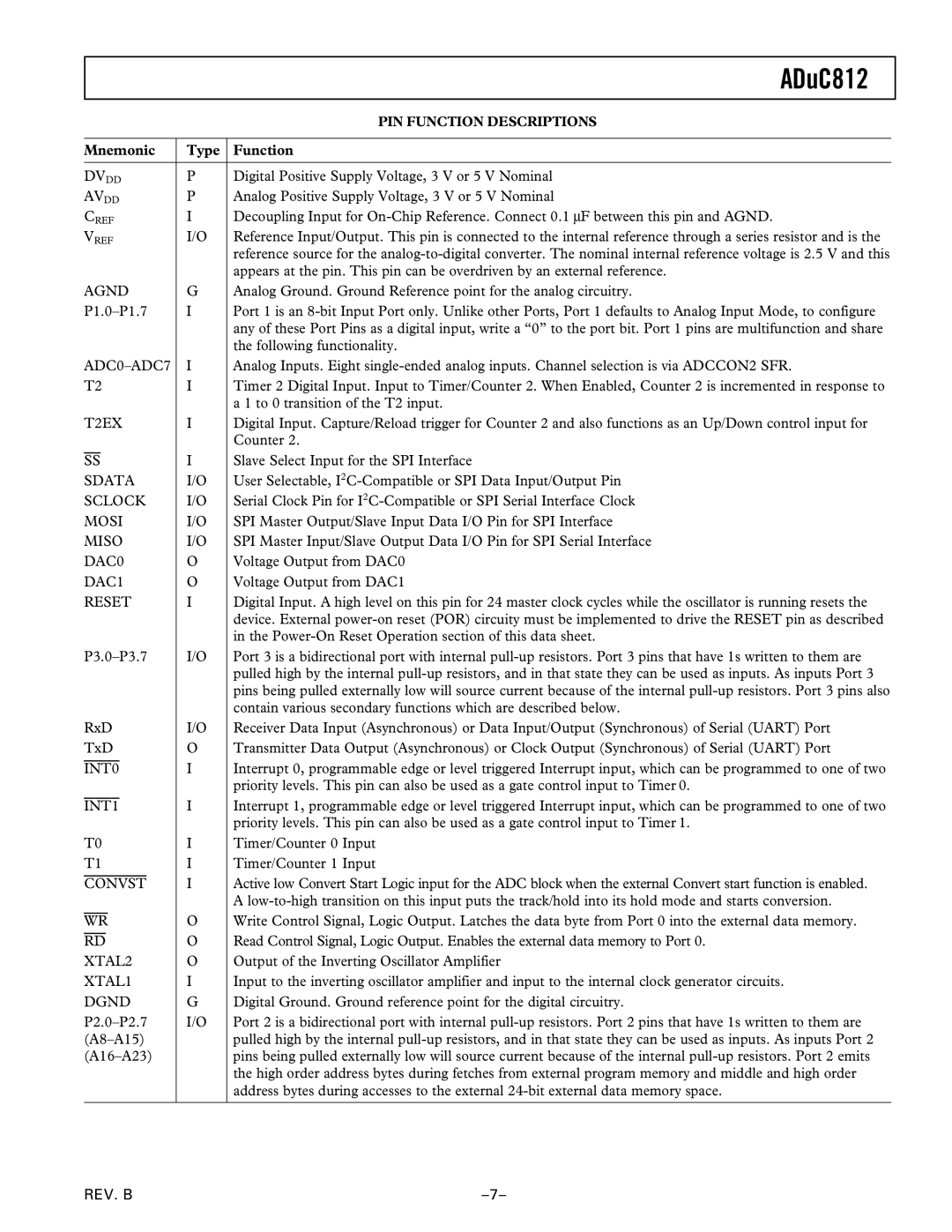
ADuC812
|
| PIN FUNCTION DESCRIPTIONS |
|
|
|
Mnemonic | Type | Function |
|
|
|
DVDD | P | Digital Positive Supply Voltage, 3 V or 5 V Nominal |
AVDD | P | Analog Positive Supply Voltage, 3 V or 5 V Nominal |
CREF | I | Decoupling Input for |
VREF | I/O | Reference Input/Output. This pin is connected to the internal reference through a series resistor and is the |
|
| reference source for the |
|
| appears at the pin. This pin can be overdriven by an external reference. |
AGND | G | Analog Ground. Ground Reference point for the analog circuitry. |
I | Port 1 is an | |
|
| any of these Port Pins as a digital input, write a “0” to the port bit. Port 1 pins are multifunction and share |
|
| the following functionality. |
| I | Analog Inputs. Eight |
T2 | I | Timer 2 Digital Input. Input to Timer/Counter 2. When Enabled, Counter 2 is incremented in response to |
|
| a 1 to 0 transition of the T2 input. |
T2EX | I | Digital Input. Capture/Reload trigger for Counter 2 and also functions as an Up/Down control input for |
|
| Counter 2. |
SSI Slave Select Input for the SPI Interface
SDATA | I/O | User Selectable, |
SCLOCK | I/O | Serial Clock Pin for |
MOSI | I/O | SPI Master Output/Slave Input Data I/O Pin for SPI Interface |
MISO | I/O | SPI Master Input/Slave Output Data I/O Pin for SPI Serial Interface |
DAC0 | O | Voltage Output from DAC0 |
DAC1 | O | Voltage Output from DAC1 |
RESET | I | Digital Input. A high level on this pin for 24 master clock cycles while the oscillator is running resets the |
|
| device. External |
|
| in the |
I/O | Port 3 is a bidirectional port with internal | |
|
| pulled high by the internal |
|
| pins being pulled externally low will source current because of the internal |
|
| contain various secondary functions which are described below. |
RxD | I/O | Receiver Data Input (Asynchronous) or Data Input/Output (Synchronous) of Serial (UART) Port |
TxD | O | Transmitter Data Output (Asynchronous) or Clock Output (Synchronous) of Serial (UART) Port |
INT0 | I | Interrupt 0, programmable edge or level triggered Interrupt input, which can be programmed to one of two |
|
| priority levels. This pin can also be used as a gate control input to Timer 0. |
INT1 | I | Interrupt 1, programmable edge or level triggered Interrupt input, which can be programmed to one of two |
|
| priority levels. This pin can also be used as a gate control input to Timer 1. |
T0 | I | Timer/Counter 0 Input |
T1 | I | Timer/Counter 1 Input |
CONVST | I | Active low Convert Start Logic input for the ADC block when the external Convert start function is enabled. |
|
| A |
WR | O | Write Control Signal, Logic Output. Latches the data byte from Port 0 into the external data memory. |
RD | O | Read Control Signal, Logic Output. Enables the external data memory to Port 0. |
XTAL2 | O | Output of the Inverting Oscillator Amplifier |
XTAL1 | I | Input to the inverting oscillator amplifier and input to the internal clock generator circuits. |
DGND | G | Digital Ground. Ground reference point for the digital circuitry. |
I/O | Port 2 is a bidirectional port with internal | |
| pulled high by the internal | |
| pins being pulled externally low will source current because of the internal | |
|
| the high order address bytes during fetches from external program memory and middle and high order |
|
| address bytes during accesses to the external |
REV. B |
